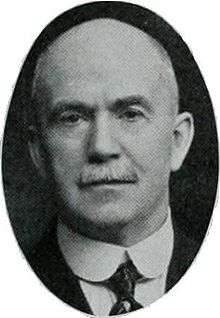Willard Young
| Willard Young | |
|---|---|
 ca. 1923 | |
| President of Young University | |
| 1891 – 1893 | |
| President of LDS Business College | |
| 1906 – 1915 | |
| Military career | |
|
1875 – 1891, 1898 – 1899 (Army) 1896 – 1898 (National Guard) | |
| Allegiance |
|
| Service/branch |
|
| Rank |
Colonel (USA) Brigadier General (Utah) |
| Unit |
United States Army Corps of Engineers Utah National Guard |
| Commands held | 2nd US Volunteer Engineer Regiment |
| Battles/wars | Spanish–American War |
| Personal details | |
| Born |
April 30, 1852 Salt Lake City, Utah Territory |
| Died |
July 25, 1936 (aged 84) Salt Lake City, Utah |
| Resting place |
Salt Lake City Cemetery 40°46′38″N 111°51′29″W / 40.7772°N 111.858°W |
| Spouse(s) | Harriet Hooper |
| Children | 3 |
| Parents |
Brigham Young Clarissa Ross Young |
Willard Young (April 30, 1852 – July 25, 1936) was a prominent member of The Church of Jesus Christ of Latter-day Saints (LDS Church) who served for many years in the United States military, and later held high positions within the LDS Church's administration. He also served as an educational leader.
Born in Salt Lake City, Utah Territory, Young was the son of Brigham Young and Clarissa Ross Young. His mother died when he was six, and after this Zina D. H. Young acted as his mother.[1] Young is at times described as Zina's "foster son".[2]
In 1860, Young was baptized a member of the LDS Church by James Works.
In 1871, Young began as a cadet at West Point. He graduated from West Point in 1875 and was appointed a second lieutenant with the United States Army Corps of Engineers. From 1875 to 1877 he was stationed at Willets Point, New York. From 1877 to 1879 he worked under Lieutenant Wheeler in the geographical survey in of the United States west of the 100th meridian.[3]
From 1879 to 1883 Young was an instructor and then a professor at West Point.[3]
Young married Harriet Hooper on August 1, 1882. She was the daughter of Willam H. Hooper. Young was ordained a seventy in 1891 and served as a Mutual Improvement Association Missionary in Davis, Weber and Box Elder counties in northern Utah.[1] While working for the Corps of Engineers, Young was involved in making detailed maps of northern Utah and southern Idaho.[4]
Young was the local supervisor in the construction of the Cascade Locks in Oregon.[3] In 1886 Young was advanced to the rank of captain. From October 1889 to June 1890 Young was stationed in Memphis, Tennessee, supervising the Third District of the Mississippi River.[3]
In 1891, Young resigned from the Army. From 1891 until 1893 Young served as president of Brigham Young University.[3] From 1893 to 1895 Young was city engineer for Salt Lake City. He then was appointed Utah's first state engineer, a position he held until the start of the Spanish–American War.[3]
In 1896 Young was appointed brigadier-general of the Utah National Guard. He was still serving in this position when the Spanish–American War began. He was a key figure in organizing the Utah volunteers. He then was appointed a colonel in the Second Regiment, U.S. Volunteer Engineers. He eventually went to Cuba and served in the army until May 16, 1899.[3]
From 1906 until 1915 Young was the president of the LDS Business College.[3][5][6] In this position he had responsibility for general supervision of the Deseret Gym.[7]
From 1907 Young served as an alternate member of the Ensign Stake High Council.
From January 1916 until July 1917 Young served as an assistant to the president of the Logan Utah Temple.[1] With the outbreak of World War I, Young again joined the army. During the war he was in charge of the Kansas City Engineer District.[3]
In 1919 Young was made superintendent of the LDS Church's building activities.[8][9] From 1923, this department supervised the building of meetinghouses and seminary buildings, providing the architectural plans for the buildings.[10]
References
- 1 2 3 Jenson, Andrew. Latter-day Saint Biographical Encyclopedia (Salt Lake City, Utah: Andrew Jenson Historical Company, 1920). Vol. 3 p. 575.
- ↑ Augusta Joyce Crocheron (1884). Representative Women of Deseret: A Book of Biographical Sketches to Accompany the Picture Bearing the Same Title at rootsweb.com
- 1 2 3 4 5 6 7 8 9 Jenson. Biographical Encyclopedia. Vol. 3, p. 576
- ↑ Historic Maps » by Young, Willard, at davidrumsey.com.
- ↑ Jenson, Andrew. Encyclopedic History of the Church of Jesus Christ of Latter-day Saints (Salt Lake City: Deseret News Publishing Company, 1941) p. 417
- ↑ Thomas G. Alexander (1996). Mormonism in Transition. University of Illinois Press. ISBN 0-252-06578-6.
- ↑ Reviews: Mahonri Young: His Work and Art, at signaturebooks.com
- ↑ Jenson. Biographical Encyclopedia. Vol. 3 p. 575–576.
- ↑ Jenson. Encyclopedic History. p. 139
- ↑ Anderson, Paul L.; Jackson, Richard H. (1992). "Building Program". In Ludlow, Daniel H. Encyclopedia of Mormonism. New York: Macmillan Publishing. p. 236-238. ISBN 0-02-879602-0. OCLC 24502140.